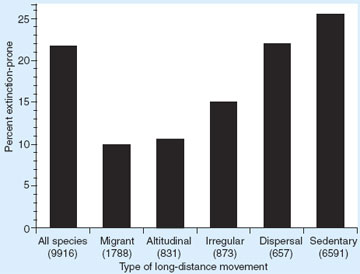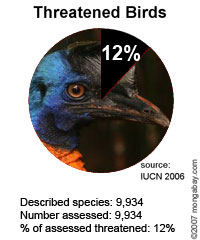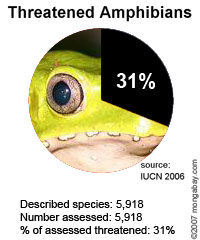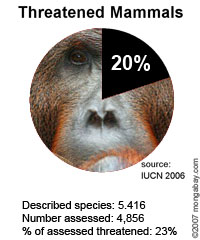Sedentary, not migratory birds, face higher extinction risk
Sedentary, not migratory birds, face higher extinction risk
Rhett A. Butler, mongabay.com
June 24, 2007
Sedentary birds face considerably higher risk of extinction than migratory birds, reports a new paper published in the journal Current Biology. The findings have implications for the conservation of increasingly endangered wildlife populations.
While reviewing studies based on nearly 50,000 bird captures from the long-running Biological Dynamics of Forest Fragments Project (BDFFP) in the Brazilian Amazon, Stanford University biologist Dr. Cagan Sekercioglu analyzed a database, covering all the world’s bird species, he has compiled since 2002. He reports that sedentary birds, which make up most of the world’s bird species, face an extinction risk 2.6 higher than migrant birds.
“Everything else being equal, mobility reduces the extinction risk of birds, defined as being threatened or near threatened with extinction” Sekercioglu told mongabay.com, noting that highly specialized birds, like those that follow army ants in tropical forests, face even greater extinction risks.
 Of the world’s IUCN redlisted birds, the highest proportion of extinction-prone species (extinct, threatened or near threatened) is found among sedentary species. Chart from Sekercioglu, C. H. (2007). Conservation ecology: area trumps mobility in fragment bird extinctions. Current Biology 17 (8): R283-R286 |
“Specialization overrides mobility,” he said. “Specialized birds are more vulnerable to extinction, even if they are mobile. Increased specialization correlates highly with increased extinction risk.”
Because they are dependent on specific habitats, niches and behaviors, sedentary and specialized birds face particular risks from habitat loss, which can be result from deforestation, fragmentation, and climate change. Migrant birds can look for alternative nesting and feeding sites in altered landscapes, though these can still fall short of meeting a species’ needs for survival.
Habitat conservation is the key to protecting sedentary and specialized bird species
Sekercioglu says the results emphasize the importance of conserving large tracts of primary forest habitats for sedentary and specialized bird species.
“Highly specialized birds, like the army ant-followers mentioned in the Current Biology article, can go extinct following fragmentation even if they are also highly mobile,” Sekercioglu explained. “This means that although habitat connectivity is important for many species and corridors have an important role, for some species, especially tropical forest species, we simply need extensive areas of primary habitat. High mobility does not make up for the loss of habitat for habitat specialists like ant-followers.”
Sekercioglu says field studies in Costa Rica confirm these observations.

|
“The birds that persisted in the agricultural landscapes are less specialized frugivores, omnivores and insectivores and in their case, mobility enabled them to persist,” he said of his 2002 paper published in PNAS. “But most specialized insectivores disappeared from this landscape.”
The research suggests that efforts focused exclusively on habitat conservation in temperate regions may not help protect most bird species.
“It is important to conserve migrant birds, many of which are declining,” said Sekercioglu. “The Neotropical Migratory Bird Conservation Act also helps conserve many tropical sedentary birds by helping protect Neotropical migrants’ winter habitats.”
“Nevertheless, the public needs to realize that on average, sedentary birds, especially in the tropics are more threatened with extinction than migrant birds. Therefore, we need to spend much more on conservation efforts in the tropics where the majority of the world’s species live.”
Sekercioglu adds that tropical forest conservation also benefits other groups of animals.
“Most groups (e.g. amphibians, reptiles, mammals, obviously plants) consist of individuals that are mostly or entirely sedentary, which partially explains why these groups are more threatened than birds. Therefore, conservation status of sedentary birds is more representative of the conservation status of other animals, but even sedentary bird species, on average, are doing better than other animal groups.”
CITATIONS
- Cagan H. Sekercioglu (2007). Conservation Ecology: Area Trumps Mobility in Fragment Bird Extinctions. Current Biology 17 (8): R283-R286
- Sekercioglu, C.H., Daily, G.C., and Ehrlich, P.R. (2004). Ecosystem consequences of bird declines. Proceedings of the National Academy of Sciences 101, 18042—18047.

